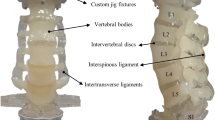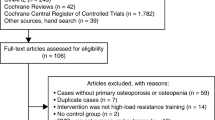Abstract
Both stiffness and strength of bones are thought to be controlled by the “bone mechanostat”. Its natural stimuli would be the strains of bone tissue (sensed by osteocytes) that are induced by both gravitational forces (body weight) and contraction of regional muscles. Body weight and muscle mass increase with age. Biomechanical performance of load-bearing bones must adapt to these growth-induced changes. Hypophysectomy in the rat slows the rate of body growth. With time, a great difference in body size is established between a hypophysectomized rat and its age-matched control, which makes it difficult to establish the real effect of pituitary ablation on bone biomechanics. The purpose of the present investigation was to compare mid-shaft femoral mechanical properties between hypophysectomized and weight-matched normal rats, which will show similar sizes and thus will be exposed to similar habitual loads. Two groups of 10 female rats each (H and C) were established. H rats were 12-month-old that had been hypophysectomized 11 months before. C rats were 2.5-month-old normals. Right femur mechanical properties were tested in 3-point bending. Structural (load-bearing capacity and stiffness), geometric (cross-sectional area, cortical sectional area, and moment of inertia), and material (modulus of elasticity and maximum elastic stress) properties were evaluated. The left femur was ashed for calcium content. Comparisons between parameters were performed by the Student’s t test. Average body weight, body length, femur weight, femur length, and gastrocnemius weight were not significantly different between H and C rats. Calcium content in ashes was significantly higher in H than in C rats. Cross-sectional area, medullary area, and cross-sectional moment of inertia were higher in C rats, whereas cortical area did not differ between groups. Structural properties (diaphyseal stiffness, elastic limit, and load at fracture) were about four times higher in hypophysectomized rats, as were the bone material stiffness or Young’s modulus and the maximal elastic stress (about 7×). The femur obtained from a middle-aged H rat was stronger and stiffer than the femur obtained from a young-adult C rat, both specimens showing similar size and bone mass and almost equal geometric properties. The higher than normal structural properties shown by the hypophysectomized femur were entirely due to changes in the intrinsic properties of the bone; it was thus stronger at the tissue level. The change of the femoral bone tissue was associated with a high mineral content and an unusual high modulus of elasticity and was probably due to a diminished bone and collagen turnover.

Similar content being viewed by others
References
K.C. Thorngreen, L.J. Hanson, K. Menendez-Sellman, A. Strenstrom, Effect of hypophysectomy on longitudinal bone growth in the rat. Calcif. Tissue Int. 11, 281–300 (1973)
O.G.P. Isakson, A. Lindahl, A. Nilsson, J. Isgaard, Mechanism of the stimulatory effect of growth hormone on longitudinal bone growth. Endocr. Rev. 8, 426–438 (1987)
D.A. Martínez, A.C. Vailas, R.E. Grindeland, Cortical bone maturation in young hypophysectomized rats. Am. J. Physiol. 260, E690–E694 (1991)
J.K. Yeh, H.M. Chen, J.F. Aloia, Skeletal alterations in hypophysectomized rats. I. A histomorphometric study on tibial cancellous bone. Anat. Rec. 241, 505–512 (1995)
H.M. Chen, J.K. Yeh, J.F. Aloia, Skeletal alterations in hypophysectomized rats. II. A histomorphometric study on tibial cortical bone. Anat. Rec. 241, 513–518 (1995)
C.H. Li, M.E. Simpson, H.M. Evans, Influence of growth and adrenocorticotropic hormones on the body composition of the hypophysectomized rat. Endocrinology 44, 71–75 (1949)
C.E. Bozzini, J.A. Kofoed, H.F. Niotti, R.M. Alippi, J.A. Barrionuevo, Relationship of red cell mass and energy metabolism to lean body mass in hypophysectomized rats. J. Appl. Physiol. 29, 10–12 (1970)
C.E. Bozzini, Decrease in the number of erythrogenic elements in the blood-forming tissues as the cause of anemia in hypophysectomized rats. Endocrinology 77, 977–986 (1965)
J.D. Currey, Bones: Structure and Mechanisms (Princeton University Press, Princeton, 2002)
J.L. Ferretti, L.C. Cointry, R.F. Capozza, H.M. Frost, Bone mass, bone strength, muscle-bone interactions, osteopenias and osteoporoses. Mech. Ageing Dev. 124, 269–279 (2003)
H.M. Frost, The mechanostat: a proposal pathogenic mechanism of osteoporosis and the bone mass effects of mechanical and nonmechanical agents. Bone Miner. 1, 73–85 (1987)
R.M. Alippi, M.I. Olivera, C. Bozzini, P.A. Huygens, C.E. Bozzini, Changes in material and architectural properties of rat femora diaphysis during ontogeny in hypophysectomized rats. Comp. Clin. Path. 14, 76–80 (2005)
R.M. Alippi, M.I. Olivera, C. Bozzini, P. Mandalunis, C.E. Bozzini, Mandibular bone stiffening and increased bone calcium mass in rats permanently stunted by hypophysectomy. Arch. Oral Biol. 51, 876–882 (2006)
S. Feldman, G.R. Cointry, M.E. Leite Duarte, L. Sarrió, J.L. Ferretti, R.F. Capozza, Effects of hypophysectomy and recombinant human growth hormone on material and geometric properties and the pre- and post-yield behavior of femurs in young rats. Bone 34, 203–215 (2004)
G.M. Kiebzak, R. Smith, C.C. Gundberg, J.C. Howe, B. Sacktor, Bone status of senescent male rats: chemical, morphometric, and mechanical analysis. J. Bone Miner. Res. 3, 37–45 (1988)
O. Akkus, F. Adar, M.B. Schaffler, Age-related changes in physicochemical properties of mineral crystals are related to impaired mechanical function of cortical bone. Bone 34, 443–453 (2004)
C. Bozzini, A.C. Barcelo, R.M. Alippi, T.L. Leal, C.E. Bozzini, The concentration of dietary casein required for normal mandibular growth in the rat. J. Dent. Res. 68, 840–841 (1989)
C.H. Turner, D.B. Burr, Basic biomechanical measurements of bone: a tutorial. Bone 14, 595–608 (1993)
H.A. Hogan, J.A. Groves, H.W. Simpson, Long-term alcohol consumption in the rat affects cross-sectional geometry and bone tissue material properties. Alcohol. Clin. Exp. Res. 23, 1825–1833 (1999)
E.L. Barengolts, H.F. Gajardo, T.I. Rosol, J.J. D’Anza, M. Pena, J. Botsis, S.C. Kukreja, Effects of progesterone on postovariectomy bone loss in aged rats. J. Bone Miner. Res. 11, 1143–1147 (1990)
J.M. Hughes, M.A. Petit, Biological underpinnings of Frost’s mechanostat thresholds: the importance of osteocytes. J. Musculoeskelet. Neuronal. Interact. 10, 128–135 (2010)
A.W. Friedman, Important determinants of bone strength. Beyond bone mineral density. J. Clin. Rheumatol. 12, 70–77 (2006)
C.H. Turner, Biomechanics of bone: determinants of skeletal fragility and bone quality. Osteoporos. Int. 13, 97–104 (2002)
E. Seeman, Clinical review 137: sexual dimorphism in skeletal size, density, and strength. J. Clin. Endocrinol. Metab. 86, 4576–4584 (2001)
H.M. Frost, Bone’s mechanostat: a 2003 update. Anat. Rec. Part A 255A, 1081–1101 (2003)
D.B. Burr, The contribution of the organic matrix to bone’s material properties. Bone 31, 8–11 (2002)
E. Seeman, P.D. Delmas, Bone quality—the material and structural basis of bone strength and fragility. N. Eng. J. Med. 354, 2250–2261 (2006)
G. Boivin, P.J. Meunier, Changes in bone remodeling rate influence the degree of mineralization of bone. Connect. Tissue Res. 43, 535–537 (2002)
J. Compston, Bone quality: what is it and how is it measured. Arq. Bras. Endocrinol. Metab. 50, 579–585 (2006)
H. Oxlund, G. Barckman, G. Ortoft, T.T. Andreassen, Reduced concentration of collagen cross-links are associated with reduced strength of bone. Bone 17, 365S–371S (1995)
P.A. Downey, M.I. Siegel, Bone biology and the clinical implications for osteoporosis. Phys. Ther. 86, 77–90 (2006)
M.I. Conti, M.P. Martínez, M.I. Olivera, C. Bozzini, P. Mandalunis, C.E. Bozzini, R.M. Alippi, Biomechanical performance of diaphyseal shafts and bone tissue of femurs from hypothyroid rats. Endocrine 36, 291–298 (2009)
C.C. Danielsen, L. Mosekilde, B. Svenstrup, Cortical bone mass, composition, and mechanical properties in female rats in relation to age, long-term ovariectomy, and estrogen substitution. Calcif. Tissue Int. 52, 26–33 (1993)
H. Jiang, J. Zhao, H.K. Genant, J. Dequeker, P. Geusens, Long-term changes in bone mineral and biomechanical properties of vertebrae and femur in aging, dietary calcium restricted, and/or estrogen-deprived/-replaced rats. J. Bone Min. Res. 12, 820–831 (1997)
M.M. Chen, J.K. Yeh, J.F. Aloia, Effect of ovariectomy on cancellous bone in the hypophysectomized rat. J. Bone Min. Res. 10, 1334–1342 (1995)
Acknowledgments
This investigation was supported by research grants from the University of Buenos Aires (UBACYT 20020100100389 and 20020100100067). RMA and CEB are Career Investigators from the National Council of Scientific and Technical Research (CONICET).
Conflict of interest
The authors declare that they have no conflict of interest.
Ethical standards
Authors declare that the experiments comply with the current laws of the country in which they were performed.
Author information
Authors and Affiliations
Corresponding author
Rights and permissions
About this article
Cite this article
Bozzini, C., Picasso, E.O., Champin, G.M. et al. Biomechanical properties of the mid-shaft femur in middle-aged hypophysectomized rats as assessed by bending test. Endocrine 42, 411–418 (2012). https://doi.org/10.1007/s12020-012-9616-0
Received:
Accepted:
Published:
Issue Date:
DOI: https://doi.org/10.1007/s12020-012-9616-0




